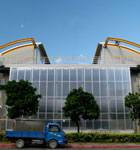Sustainable design was the natural choice when World Resources Company—an environmental company based in Taiwan—decided to construct a new building to house a processing facility and offices. “Being a recycling outfit, they wanted to be sustainable,” says William Swafford, a design specialist with Virginia Beach-based SteelMaster Buildings, which manufactures prefabricated corrugated steel building systems that offer quality and durability within a versatile, architectural-arch design. “They knew we’d be able to help them get their LEED [certification].”
Their confidence, says Swafford, was a result of World Resources Company’s familiarity with SteelMaster. In 2006, when World Resources Company was seeking to build its headquarters in Taiwan, it found SteelMaster through an Internet search for companies that construct vaulted roof facilities from corrugated steel. “I believe they selected us because we let our customers go wild with their imagination, then try to accomplish their goals within realm of our engineering and manufacturing capabilities,” Swafford says.
That was certainly the case with the World Resources Company headquarters. The project went so well that when World Resources Company decided to build a second facility for processing, it turned to SteelMaster again. “Our contact at World Resources Company sketched up a building and asked me we could do something like that,” says Swafford. “We said yes, and over the next year, World Resources Company architects worked with our engineers on the design. In 2010 they signed off on drawings, we manufactured the panels based on the approved specifications, and we shipped it in pieces to be bolted together on-site in Taiwan.”
“You can fit a large structure into an extraordinarily small case. The best way to picture it is to imagine a can of Pringles. Our panels are shaped like a chip, and they stack together that way.”
-William Swafford, SteelMaster Buildings
That’s the typical production process for SteelMaster, which starts by manufacturing deep corrugated steel panels and then forms them into prefabricated arch-type steel buildings or other objects. “At the end of day, our proprietary component, which customers such as World Resources Company seek, is our corrugated steel panel with a post-consumer and post-industrial recycled content of around 90 percent,” Swafford says. “They can then be used to make anything from a building to a fence.”
The second World Resources Company facility, now under construction, is a two-part 8,300-square-foot building with a truss system that spans the width of the second floor. The part of the building SteelMaster was responsible for—the roof—spans both buildings and the space between, where an earth-covered surface acts as a rooftop garden.
The roof itself is highly energy efficient. Traditional dark asphalt shingle roofs absorb solar radiation, making a building hot during the summer months. In contrast, Energy Star-rated metal roofing materials, such as SteelMaster corrugated steel panels, reflect a high percentage of the sun’s energy back into the atmosphere, lowering building temperatures and, subsequently, cooling loads. Studies conducted by the Cool Metal Roofing Coalition and Oak Ridge National Laboratory have shown that energy-efficient metal roofing materials, when combined with Energy Star-rated reflective paint systems, can save up to 40 percent on cooling costs versus asphalt shingle roofing.
But energy efficiency isn’t the only sustainable factor World Resources Company considered when selecting SteelMaster. SteelMaster’s corrugated steel also produce a minimal amount of waste. “The steel comes into our facility on coils, and we’re not cutting chunks off that get thrown away,” Swafford says. “The only real waste is the plugs where we punch holes for bolts to go through, and those plugs are recycled.”
Additionally, shipping is very efficient, resulting in a reduced carbon footprint. “You can fit a large structure into an extraordinarily small case,” says Rob Poellnitz, vice president of international sales for SteelMaster. “The best way to picture it is to imagine a can of Pringles. Our panels are shaped like a chip, and they stack together that way. As a result, we shipped all of the World Resources Company building materials in three containers.”

